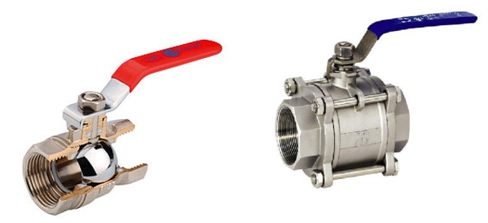Ball valves have a ball as a disc with a hole of either same diameter as pipe (full port ball valve) or a smaller hole (reducer port ball valve). Quarter turn handlever is used as operator for the ball valve. They are similar to plug valves in operation.
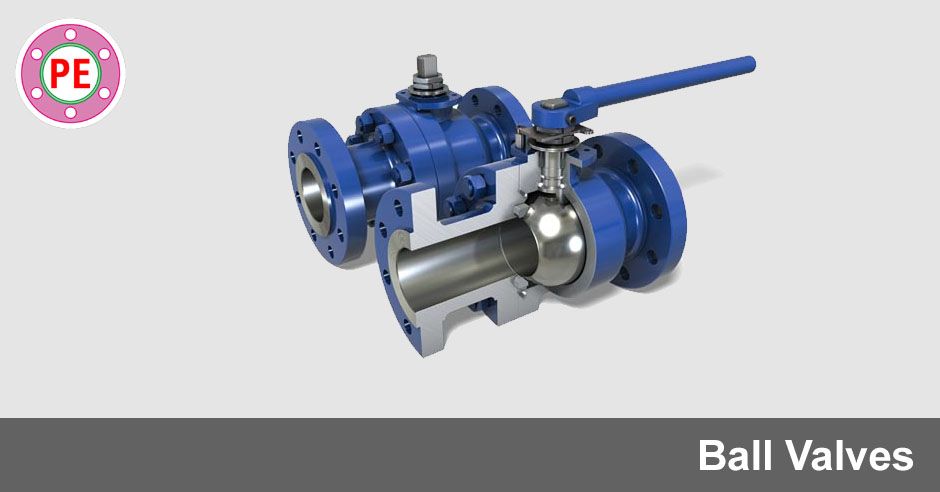
Ball valves are suitable for clean gas, compressed air, and liquid service. The can also be suitable for slurry service but provision for preventing buildup of solids must be made.
Seat Materials
- Soft seat materials such as nylon, delrin, synthetic rubbers and fluorinated polymers provide excellent sealing ability.
- Fluorinated polymer seats : Service temperatures ranging from -450 to 500 F (-270 to 260 C).
- Graphite seats : Service temperatures upto 1000 F (538 C) or even higher.
- Metal Backing Seats : Fire Safe services.
Advantages
- They are nonbinding and provide leak-tight closure.
- The valves exhibit negligible resistance to flow because of their smooth body and port.
- They are available in large sizes.
- They are compact. Smaller in size than gate valve.
- They have rotary 90-degree stem movement.
- In some designs, wearing parts can be replaced in-line without removing form the pipeline.
- Provides bubble-tight service.
- Quick to open and close.
- Lighter in weight than a gate valve.
- Multiport design offers versatility not available with gate or globe valves. It reduces the number of valves required.
- Several designs of ball valves offer flexibility of selection.
- Can be used in clean and slurry applications.
- High-quality ball valves provide reliable service in high-pressure and high-temperature applications.
- Force required to actuate the valve is smaller than that required for a gate or a globe valve.
Disadvantages
- Fluid is trapped within the body (and within the disc on closure).
- Compensation for wear is effected only by resilient material behind the seats: This problem is avoided in the single-seat eccentric version, which has the ball slightly offset so that it presses into the seat, on closure.
- They are not suitable for sustained throttling applications.
- In slurry or other applications, the suspended particles can settle and become trapped in body cavities causing wear, leakage, or valve failure.
Applications
- Principal uses are for water, oils, slurries, gases and vacuum.
- Valve is available with a ball having a shaped port for regulation.
- Air, gaseous, and liquid applications requiring bubble-tight service.
- Low-point drains and high-point vents in liquid, gaseous, and other fluid services.
- Instrument root valves.
- Cooling water and feedwater systems.
- Steam service
Construction
- Major componentsare the body, spherical plug, and seats.
- Porty Types : They are made in three general patterns: venturi port, full port, and reduced port. The full-port valve has an inside diameter equal to the inside diameter of the pipe. In the venturi and reduced-port styles, the port is generally one pipe size smaller than the line size.
- Sealing : Stem sealing is accomplished by bolted packing glands and O-ring seals. Valves are also available with a lubricant-seal system that is similar to that available for plug valves.
- Port Numbers : A ball valve may be unidirectional, bidirectional, or multidirectional, depending on the number of valve ports and the number of valve seats. Therefore, ball valves are referred to as 2-way, 3-way, 4-way, or 5-way multiport valves. A 2-way ball valve with a single seat will be unidirectional with the flow direction indicated. Even a 3-way, 4-way, or 5-way ball valve can be unidirectional when flow must enter through a designated port. A 2-way ball valve provided with two seats, one on the upstream side and the other on the downstream side of the ball, is termed a bidirectional valve. Multiple-port ball valves permit flows in more than one direction, thus eliminating the need for several valves.
- Body configurations: top entry, side entry, split body, and three-piece body.
- Valve ends : buttwelding, socket welding, flanged, threaded, soldering, or brazing ends.
- Pressure : High- and low-pressure classifications.
Split Body Ball Valve
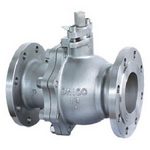 This valve consists of a two-part body, a cover, ball, seat rings, stem, and other internals. The two-part body is held together by a flange connection. One body part is smaller than the other. The ball is inserted in the larger body part, and the smaller body part is assembled by a bolted connection. The stuffing box is constructed integral with the larger body part. On smaller size split-body ball valves, the two-part body is joined by threaded connection. The flanged or threaded joint between the two-part body is an added source of potential leakage. Flanged end connections are commonly available on all sizes; however, they are standard for large size valves. NPS 2 (DN 50) and smaller split-body ball valves are furnished with screwed ends. The split-body ball valves are manufactured in sizes ranging from NPS 1⁄2 (DN 15) through NPS 36 (DN 900).
This valve consists of a two-part body, a cover, ball, seat rings, stem, and other internals. The two-part body is held together by a flange connection. One body part is smaller than the other. The ball is inserted in the larger body part, and the smaller body part is assembled by a bolted connection. The stuffing box is constructed integral with the larger body part. On smaller size split-body ball valves, the two-part body is joined by threaded connection. The flanged or threaded joint between the two-part body is an added source of potential leakage. Flanged end connections are commonly available on all sizes; however, they are standard for large size valves. NPS 2 (DN 50) and smaller split-body ball valves are furnished with screwed ends. The split-body ball valves are manufactured in sizes ranging from NPS 1⁄2 (DN 15) through NPS 36 (DN 900).
Top Entry Ball Valve
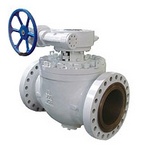 Top-entry ball valves allow access to valve internals for assembly, disassembly, repair, or maintenance by removal of the valve bonnet-cover. The valve is not required to be removed from the pipeline.
Top-entry ball valves allow access to valve internals for assembly, disassembly, repair, or maintenance by removal of the valve bonnet-cover. The valve is not required to be removed from the pipeline.
End Entry Ball Valve
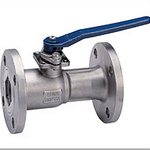 End-entry ball valves have a single-piece body. The ball is inserted from one end and is retained by an insert. These valves have flange- or screwed-end connections. This design is commonly used for inexpensive small valves. They are also available in larger sizes up to NPS 6 (DN 150).
End-entry ball valves have a single-piece body. The ball is inserted from one end and is retained by an insert. These valves have flange- or screwed-end connections. This design is commonly used for inexpensive small valves. They are also available in larger sizes up to NPS 6 (DN 150).
[google-square-ad]
Three Piece Body Ball Valve
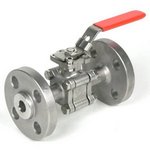 The middle part of the valve is the major part that holds all valve internals, and the stem passes through a hole in the top. Two end caps are held together with the middle body by bolts or studs and nuts. The end connections are part of the end caps, and they may be butt-welding, socketwelding, threaded, or flanged. This design is available in sizes ranging from NPS 1⁄2 (DN 15) through NPS 36 (DN 900). The two end cap joints are two additional sources of potential leakage.
The middle part of the valve is the major part that holds all valve internals, and the stem passes through a hole in the top. Two end caps are held together with the middle body by bolts or studs and nuts. The end connections are part of the end caps, and they may be butt-welding, socketwelding, threaded, or flanged. This design is available in sizes ranging from NPS 1⁄2 (DN 15) through NPS 36 (DN 900). The two end cap joints are two additional sources of potential leakage.
Double Trunion Ball Valve
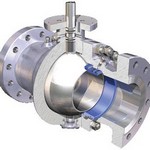 In this ball-valve design, the ball is provided with two integral short-shaft extensions called the top and the bottom trunnions. These trunnions are fitted in bearings and rotate freely when the shaft installed in the top trunnion is turned to open or close the valve. The ball is held firmly in place, unlike the ball in other designs where the ball is supported by the two seat rings and is allowed to float in the direction of the slot on top of the ball. A shaft installed in the top slot is turned to open or close the valve. The trunnion-mounted ball-valve design is used with split-body large size valves, whereas the floating-ball design is the most common design for all other types of ball valves. The torque required to actuate a trunnion-mounted ball valve is substantially smaller than the torque required for a floating-ball design.
In this ball-valve design, the ball is provided with two integral short-shaft extensions called the top and the bottom trunnions. These trunnions are fitted in bearings and rotate freely when the shaft installed in the top trunnion is turned to open or close the valve. The ball is held firmly in place, unlike the ball in other designs where the ball is supported by the two seat rings and is allowed to float in the direction of the slot on top of the ball. A shaft installed in the top slot is turned to open or close the valve. The trunnion-mounted ball-valve design is used with split-body large size valves, whereas the floating-ball design is the most common design for all other types of ball valves. The torque required to actuate a trunnion-mounted ball valve is substantially smaller than the torque required for a floating-ball design.
Lubricated or Non Lubricated
Like other valves, the stem sealing is usually accomplished by bolted packing glands and O-ring seals. Some valve designs are available with a lubricant-seal system similar to the one used in plug valves. The valves with lubrication seal systems are termed lubricated ball valves, while others are called non lubricated.
Sample Specification
Element : Ball Valve
Small Bore Valve Ends : for small bore valve, with spool pieces if PTFE Seats used to avoid damaging seats during welding. BW ends if metal seats used.
Big bore valve Ends : Flanged ends, Raised face or other as per spec.
Pattern : Short Pattern for small bore. Long pattern for flanged to match with gate valve dimensions.
Bore : Reduced bore or full bore as per process requirement.
Small Bore Forged Body : ASTM A105 for CS, ASTM A182 Gr. F304L for SS with NACE, HIC if required.
Big Bore Cast Body : ASTM A216 Gr. WCB for CS, ASTM A351 Gr. CF3 with NACE, HIC etc as required.
Class : 150#, 300# etc. as per spec.
Dim Standard : ASME B16.10. Manufacturer Standard for SW Valves or with nipples
Ball : 316 SS, 304 SS
Stem : 316 SS, 304 SS
Seat : RPTFE or Metal Seat if Welding end valve without nipples.
Operator : Lever upto 6”. Gear operator from 8”.
 | 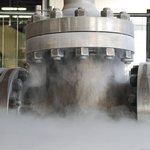 | |
| Ball valves are used extensively in cryogenic services, but their design must be adapted for this …Read More.. | ||

